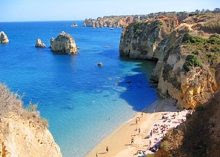Situated in the extreme Southwest of the Algarve, region of P
 ortugal, Lagos was born under the sign of the sea.
ortugal, Lagos was born under the sign of the sea.This settlement, whose origins are lost in the far distant past, has been determined by the geographical shape of its bay. In fact, the first inhabitants probably come as far as the Neolithic period. People came from the Mediterranean basin – Phoenicians, Greeks and even Carthaginians.
 The ancient city centre would have already emerged in the time of the Carthaginians bearing a definitive name – Lacóbriga.
The ancient city centre would have already emerged in the time of the Carthaginians bearing a definitive name – Lacóbriga.Various coins, remains of town walls, beautiful floor tiles prove the military, economic and cultural importance that Lacóbriga attained during the peak period of the Roman Empire that dominated the whole Mediterranean Sea.
The fall of the Roman Empire and after the conquest of the south
 of the Peninsula by the Arabs veiled this town with an obscure mystery; they called the city of Zawala.
of the Peninsula by the Arabs veiled this town with an obscure mystery; they called the city of Zawala.In 1332 the Portuguese king D. Afonso IV ordered the restoration of the town walls and placed the Algarve Military Government Headquarters within in it.
It is in Lagos that the famous scion of the Portuguese Royal Family, Infante D. Henrique or Prince Henry the Navigator chose to settle and from it the great adventure of the Portuguese Discoveries began.
 In 1434 Gil Eanes sailed from Lagos, to surpass Cabo Bojador and in 1441, the first African slaves were brought in creating the first Slave Market, which building is still standing today in central Lagos.
In 1434 Gil Eanes sailed from Lagos, to surpass Cabo Bojador and in 1441, the first African slaves were brought in creating the first Slave Market, which building is still standing today in central Lagos.In 1504 D. Manuel I gave to Lagos a new city charter and later, in 1578, D. Sebastião raised Lagos to the status of a city, and from its harbour left on a fatal expedition against the Moors in North Africa from which he never returned.

In 1755 the city was almost destroyed by an earthquake; however it re-emerged from its ashes and ruins.
Today, the town still retains the atmosphere of its great cosmopolitan heritage, a fact readily visible to the visitor in its wealth of architecture and monuments.














Sem comentários:
Enviar um comentário